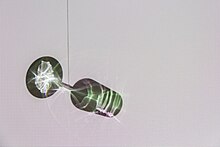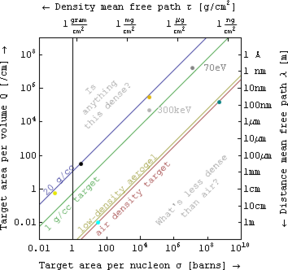Scattering
| Scattering |
|---|
 |

Scattering is a term used in physics to describe a wide range of physical processes where moving particles or radiation of some form, such as
Scattering can refer to the consequences of
The types of non-uniformities which can cause scattering, sometimes known as scatterers or scattering centers, are too numerous to list, but a small sample includes
Some areas where scattering and scattering theory are significant include radar sensing,
Scattering is quantified using many different concepts, including scattering cross section (σ), attenuation coefficients, the bidirectional scattering distribution function (BSDF), S-matrices, and mean free path.
Single and multiple scattering

When radiation is only scattered by one localized scattering center, this is called single scattering. It is more common that scattering centers are grouped together; in such cases, radiation may scatter many times, in what is known as multiple scattering.
Because the location of a single scattering center is not usually well known relative to the path of the radiation, the outcome, which tends to depend strongly on the exact incoming trajectory, appears random to an observer. This type of scattering would be exemplified by an electron being fired at an atomic nucleus. In this case, the atom's exact position relative to the path of the electron is unknown and would be unmeasurable, so the exact trajectory of the electron after the collision cannot be predicted. Single scattering is therefore often described by probability distributions.
With multiple scattering, the randomness of the interaction tends to be averaged out by a large number of scattering events, so that the final path of the radiation appears to be a deterministic distribution of intensity. This is exemplified by a
Not all single scattering is random, however. A well-controlled laser beam can be exactly positioned to scatter off a microscopic particle with a deterministic outcome, for instance. Such situations are encountered in radar scattering as well, where the targets tend to be macroscopic objects such as people or aircraft.
Similarly, multiple scattering can sometimes have somewhat random outcomes, particularly with coherent radiation. The random fluctuations in the multiply scattered intensity of coherent radiation are called
The description of scattering and the distinction between single and multiple scattering are tightly related to wave–particle duality.
Theory
This section needs additional citations for verification. (August 2023) |
Scattering theory is a framework for studying and understanding the scattering of
The direct scattering problem is the problem of determining the distribution of scattered radiation/particle flux basing on the characteristics of the scatterer. The inverse scattering problem is the problem of determining the characteristics of an object (e.g., its shape, internal constitution) from measurement data of radiation or particles scattered from the object.
Attenuation due to scattering

When the target is a set of many scattering centers whose relative position varies unpredictably, it is customary to think of a range equation whose arguments take different forms in different application areas. In the simplest case consider an interaction that removes particles from the "unscattered beam" at a uniform rate that is proportional to the incident number of particles per unit area per unit time (), i.e. that
where Q is an interaction coefficient and x is the distance traveled in the target.
The above ordinary first-order differential equation has solutions of the form:
where Io is the initial flux, path length Δx ≡ x − xo, the second equality defines an interaction mean free path λ, the third uses the number of targets per unit volume η to define an area cross-section σ, and the last uses the target mass density ρ to define a density mean free path τ. Hence one converts between these quantities via Q = 1/λ = ησ = ρ/τ, as shown in the figure at left.
In electromagnetic absorption spectroscopy, for example, interaction coefficient (e.g. Q in cm−1) is variously called
Elastic and inelastic scattering
The term "elastic scattering" implies that the internal states of the scattering particles do not change, and hence they emerge unchanged from the scattering process. In inelastic scattering, by contrast, the particles' internal state is changed, which may amount to exciting some of the electrons of a scattering atom, or the complete annihilation of a scattering particle and the creation of entirely new particles.
The example of scattering in
The term "deep inelastic scattering" refers to a special kind of scattering experiment in particle physics.
Mathematical framework
In mathematics, scattering theory deals with a more abstract formulation of the same set of concepts. For example, if a differential equation is known to have some simple, localized solutions, and the solutions are a function of a single parameter, that parameter can take the conceptual role of time. One then asks what might happen if two such solutions are set up far away from each other, in the "distant past", and are made to move towards each other, interact (under the constraint of the differential equation) and then move apart in the "future". The scattering matrix then pairs solutions in the "distant past" to those in the "distant future".
Solutions to differential equations are often posed on
An important, notable development is the
Theoretical physics
In
In regular
Electromagnetics
This section needs additional citations for verification. (January 2020) |

Light scattering is one of the two major physical processes that contribute to the visible appearance of most objects, the other being absorption. Surfaces described as white owe their appearance to multiple scattering of light by internal or surface inhomogeneities in the object, for example by the boundaries of transparent microscopic crystals that make up a stone or by the microscopic fibers in a sheet of paper. More generally, the
Spectral absorption, the selective absorption of certain colors, determines the color of most objects with some modification by
Models of light scattering can be divided into three domains based on a dimensionless size parameter, α which is defined as:
- α ≪ 1: Rayleigh scattering (small particle compared to wavelength of light);
- α ≈ 1: Mie scattering (particle about the same size as wavelength of light, valid only for spheres);
- α ≫ 1: geometric scattering (particle much larger than wavelength of light).
For larger diameters, the problem of electromagnetic scattering by spheres was first solved by
Both Mie and Rayleigh scattering are considered elastic scattering processes, in which the energy (and thus wavelength and frequency) of the light is not substantially changed. However, electromagnetic radiation scattered by moving scattering centers does undergo a
At values of the ratio of particle diameter to wavelength more than about 10, the laws of
For modeling of scattering in cases where the Rayleigh and Mie models do not apply such as larger, irregularly shaped particles, there are many numerical methods that can be used. The most common are finite-element methods which solve Maxwell's equations to find the distribution of the scattered electromagnetic field. Sophisticated software packages exist which allow the user to specify the refractive index or indices of the scattering feature in space, creating a 2- or sometimes 3-dimensional model of the structure. For relatively large and complex structures, these models usually require substantial execution times on a computer.
Electrophoresis involves the migration of macromolecules under the influence of an electric field.[21] Electrophoretic light scattering involves passing an electric field through a liquid which makes particles move. The bigger the charge is on the particles, the faster they are able to move.[22]
See also
- Attenuation#Light scattering
- Backscattering
- Bragg diffraction
- Brillouin scattering
- Characteristic mode analysis
- Compton scattering
- Coulomb scattering
- Deep scattering layer
- Diffuse sky radiation
- Doppler effect
- Dynamic Light Scattering
- Electrophoretic light scattering
- Extinction
- Haag–Ruelle scattering theory
- Kikuchi line
- Light scattering by particles
- Linewidth
- Mie scattering
- Mie theory
- Molecular scattering
- Mott scattering
- Neutron scattering
- Phase space measurement with forward modeling
- Photon diffusion
- Powder diffraction
- Raman scattering
- Rayleigh scattering
- Resonances in scattering from potentials
- Rutherford scattering
- Small-angle scattering
- Scattering amplitude
- Scattering from rough surfaces
- Scintillation (physics)
- S-Matrix
- Tyndall effect
- Thomson scattering
- Wolf effect
- X-ray crystallography
References
- ^ Newton, Isaac (1665). "A letter of Mr. Isaac Newton Containing his New Theory About Light and Colours". Philosophical Transactions. 6. Royal Society of London: 3087.
- ^ Herschel, William (1800). "Experiments on the Solar, and on the Terrestrial Rays that Occasion Heat". Philosophical Transactions. XC. Royal Society of London: 770.
- JSTOR 109101.
- ^ Merritt, Ernest (5 Oct 1898). "The Magnetic Deflection of Diffusely Reflected Cathode Rays". Electrical Review. 33 (14): 217.
- S2CID 4023635.
- ^ Rutherford, E. (1911). "The Scattering of α and β rays by Matter and the Structure of the Atom". Philosophical Magazine. 6: 21.
- ISBN 0-471-82857-2
- ISBN 978-3-540-62838-5.
- ISBN 3-540-50496-6.
- ^ "Zodiacal Glow Lightens Paranal Sky". ESO Picture of the Week. European Southern Observatory. Retrieved 2 December 2013.
- ISBN 978-0-387-98853-5.
- ISBN 978-0-387-98853-5.
- ISBN 978-0-8194-1934-7.
- ISBN 0-306-45223-5
- ISBN 3-540-62568-2
- ISBN 978-3-540-62838-5.
- ISBN 978-0-471-29340-8.
- .
- ISBN 0-471-82857-2
- S2CID 4393904.
- ^ "Understanding Electrophoretic Light Scattering". Wyatt Technology.
- ^ "Light Scattering". Malvern Panalytical.
External links
- Research group on light scattering and diffusion in complex systems
- Multiple light scattering from a photonic science point of view
- Neutron Scattering Web
- Neutron and X-Ray Scattering
- World directory of neutron scattering instruments
- Scattering and diffraction
- Optics Classification and Indexing Scheme (OCIS), Optical Society of America, 1997
- Lectures of the European school on theoretical methods for electron and positron induced chemistry, Prague, Feb. 2005
- E. Koelink, Lectures on scattering theory, Delft the Netherlands 2006




